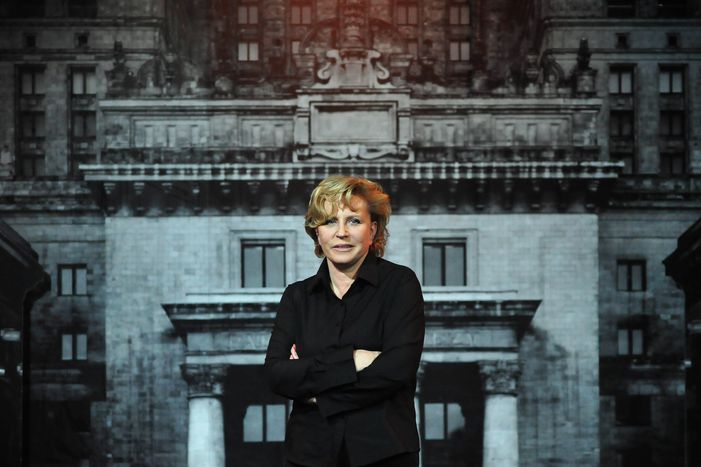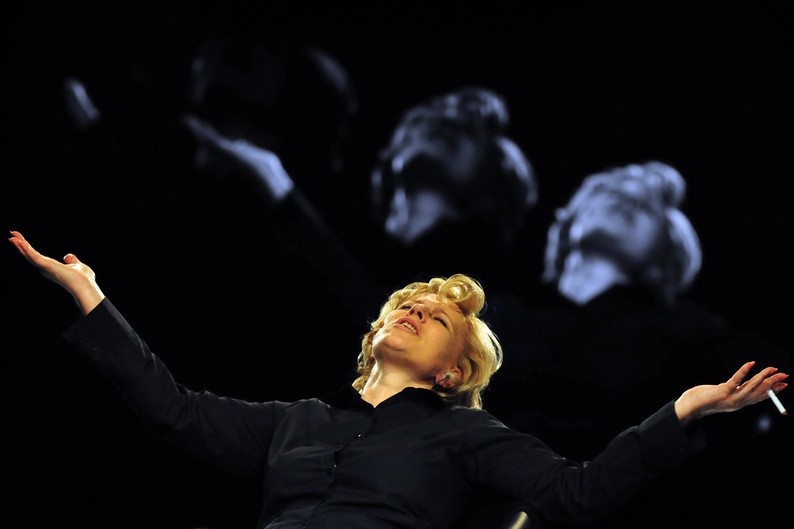
Restaging a Polish masterwork: Dissent and readjustment in The White Blouse
Published on
Translation by:
Joanna ParlakThe main character is a walking contradiction. She doesn't want, or is unable to, participate in the tidal wave of support for the Polish independence party Solidarity. Her relationship to the party is limited to her love for a man who does so. Not always deliberately, her erratic, often drunken antics, express a disagreement with the status quo, a dissent to the underlying ideals of communism.
The first theatrical adaptation of Agnieszka Osiecka’s short story The White Blouse (Polish title: Biała Bluzka) was directed by Magdalena Umer and took place in March 1987 during The Review of Stage Songs in Wroclaw. The monodrama quickly won public acclaim, as well as the attention of critics. Krystyna Janda, the actress playing the heroine, toured all over the country performing in the show. They play appealed deeply to a generation of Polish women who had grown up under communism but became activists during the era of Solidarity, (the first liberal political party in Poland following the fall of communism ed.). This generation recognised themselves in Osiecka's work, and in Janda's performance. The character of Elżbieta spoke to them on many levels; she represented their involuntary involvement in the unfair history that had deprived them of a normal life, a normal home and normal love. They saw in the play a reflection of that history which had taken away their freedom and forced them to hide their own individuality under the eponymous white blouse.
Almost twenty years after it first took to the boards of Polish theatres, Umer and Janda have decided to once again stage the famous play. This time, it's for a new generation: one born since the start of the 1980's, who can hardly remember a world without the internet, let alone the era of certification and food stamps. So, aside from being great entertainment, and a worthwhile lesson in history, what else does this show represent to the youth of today?
Ration Stamps & Cards, Certificates and the White Blouse
This new version of the play has been restored and enhanced using archive footage from the Ministry of Public Security. The clips show secret meetings among the opposition party Solidarity. It's a short, yet carefully assembled, selection of footage portraying the era's strongest pillars of Polish culture, Brandys, Halina Mikołajska, Onyszkiewicz, Kisielewski, Kołakowski, Kuroń, Michnik and many others.
The vast majority of the traditional lineup of heroes fighting for Polish freedom are men; they are portrayed as being great and heroic, devoted to the cause, ready to sacrifice their family and private lives for the sake of a free Poland. However, they were all aided in their successes by forgotten women, and the play is precisely designed to showcase those who have gone unnoticed by history. In The White Blouse a woman’s space is an empty home filled with expectation, and the enforced fulfilment of grotesque responsibilities imposed by the reality of the era. That space is grey, shallow and unitary. It is filled with ration stamps and cards, certificates and the ever present notion of the white blouse – a symbol of obedience and adjustment to the communist cause.
What if I want to achieve something great?
 The heroine is a walking contradiction. She doesn’t want to, or maybe even can’t, contribute to the tidal wave of patriotic support behind Solidarity. Her interest in the political opposition is mainly that of her relationship with Andrzej, a member of the party. Osiecka describes her heroine in the following way: “She’s a little unstable, a little funny, a little comical, and a little tragic. Entangled in an unhappy love and the misery of martial law. On one hand she’s a drinker and a madwoman with the sun in her eyes, yet on the other a perfectly arranged stickler for detail.”
The heroine is a walking contradiction. She doesn’t want to, or maybe even can’t, contribute to the tidal wave of patriotic support behind Solidarity. Her interest in the political opposition is mainly that of her relationship with Andrzej, a member of the party. Osiecka describes her heroine in the following way: “She’s a little unstable, a little funny, a little comical, and a little tragic. Entangled in an unhappy love and the misery of martial law. On one hand she’s a drinker and a madwoman with the sun in her eyes, yet on the other a perfectly arranged stickler for detail.”
Her ridiculousness, her binge drinking sessions and her buffoonery are not always a conscious rejection of the existing state of affairs; yet they symbolise everything that the Polish People's Republic has decided to take away from its citizens. This apparent craziness takes the form of an unmanageable strategy of rebellion, perfectly revealed in this moving passage where Elżbieta exposes her dissatisfaction, while at the same time showing her true subconscious motives behind her desperate behaviour: “Do you think that I don’t understand what’s happening here? That I can’t sense the wonderful word "unadaptable" hanging in the air? Into whom am I to be adapted? You? Mr. Józek? His mother, driven mad with fear? Or these hellish regulations? Did I descend from the trees to simply fit between some here and there? What if I want to achieve something great, maybe I don’t have too much time on my hands and I need to consider my losses?”
The music in the show is also significant – Osiecka's songs have been newly arranged, though still sung by Janda. The music intertwines with the spontaneous monologues, which make the performance a little lighter for the audience. When discussing the monologue, it is important to mention the use of language, which in this case is far from transparent. It's colourful, juicy, disrupted and full of aberrations. This “untwisted rhetorical machine” is not always easy to understand, but it encapsulates the mind of our heroine, filtered as it is through her own private reality. The expressive language becomes a weapon which can be used to fight for freedom, but at the same time this is the only way in which this resistance manifests; even if the history it envokes today bounces off empty walls.
Umer succeeds in focusing viewers’ attention on the most important aspect of the show – Elżbieta. She minimalises the set dressing to a lone cardboard symbol of the PRL (the Palace of Culture and Science in Warsaw). She dresses Janda in a simple black outfit and sits her on a black chair that turns on a black stage. This prescribed minimalism highlights the talent and personality of the actress, which is complemented brilliantly by the archive footage displayed on the screens behind her. The White Blouse is not only about history and language, but it is also a lovingly crafted showcase of Janda’s expressive personality, perfected through years of work on stage.
The White Blouse is a one-woman show filled with a wide array of emotions. It touches a very meaningful topic that is told in a moving, yet amusing, way. It is also an intimate, but at the same time political, story. It is Polish history told from the perspective of grey apartments and taverns. The show is a work of three talented women who not only decided to tell a story about the fate of the individual during the years of the PRL, but also a universal history surrounding the difficulties of adjustment to a new regime, and the noncomformist battle of this with one's own individuality which even a new generation must at some point experience.
Krystyna Janda, performs in "The While Blouse", Och-teatr, May 2010
---
„Biała Bluzka” in Och-Teatr
Adapted and directed by: Magda Umer
Music: Janusz Bogacki
Light: Piotr Pawlik
Cast: Krystyna Janda & Janusz Bogacki with the band
Janusz Bogacki – piano
Tomasz Bogacki – guitar
Paweł Pańta – double-bass
Bogdan Kulik – percussion
Duration: 1h 40 mins
Ticket price: 50-70 zł.
Translated from „Biała Bluzka” w Och-Teatrze – jednostka nie-przystosowana do realiów nie-normalnych



